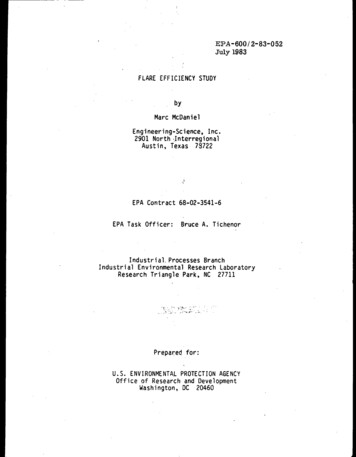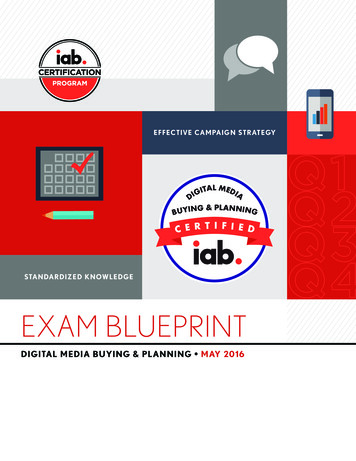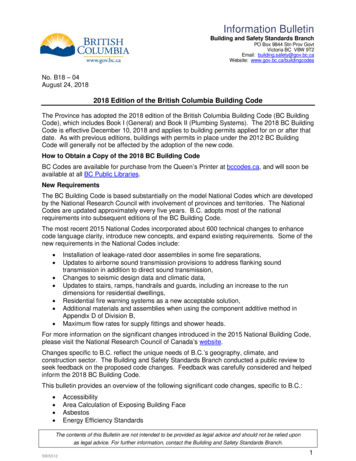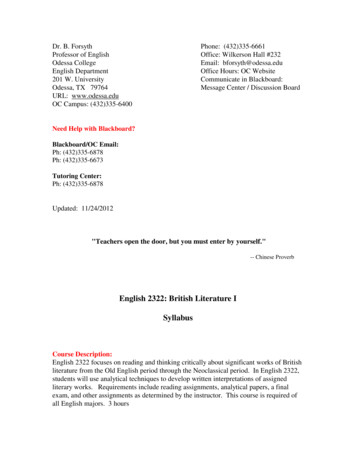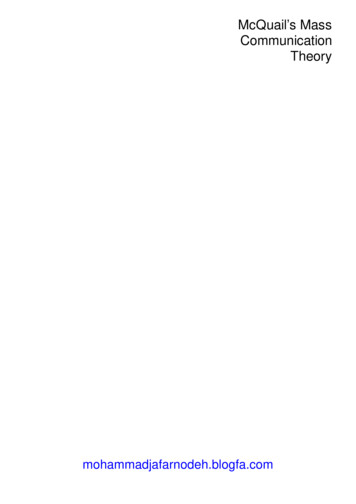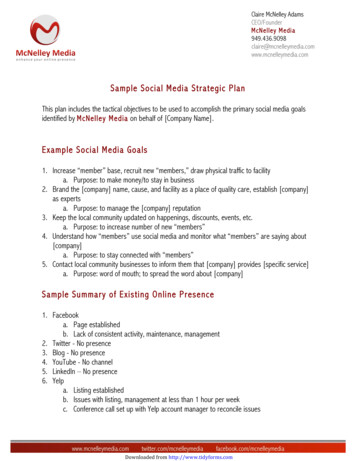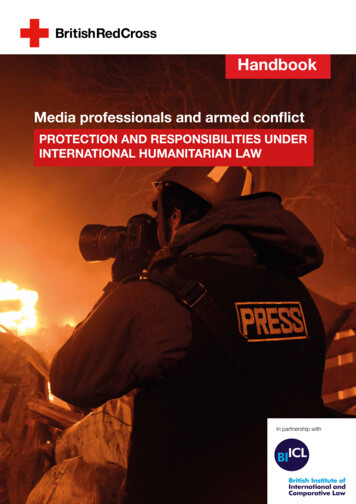
Transcription
HandbookMedia professionals and armed conflictPROTECTION AND RESPONSIBILITIES UNDERINTERNATIONAL HUMANITARIAN LAWIn partnership withPart 1. Media Professionals and International Humanitarian Law1
Front cover photo 2014 Mstyslav Chernov, some rights reserved
ForewordInternational humanitarian law (IHL), the body of international law which regulates behaviour in armedconflict, is sometimes thought to be the sole purview of governments, militaries, and internationallawyers. However, most modern armed conflicts involve and affect a complex range of groups andindividuals across society. The fact remains that IHL applies to all who find themselves caught up inarmed conflicts. Its principles and rules must therefore be understood and respected by everyone.The role of the media in reporting on armed conflicts has a long tradition, and the activities of journalistsand other media professionals in such contexts have increased over time. This being said, mediaprofessionals are, for the most part, not explicitly mentioned in the major IHL treaties. However, mediaprofessionals are generally categorised as civilians, and thereby enjoy all of the safeguards extended byIHL to this broad group. It is therefore in the interests of all media professionals reporting from conflictzones, as well as their employing organisations and those who are otherwise responsible for them, to beaware of how they are protected under IHL.Media professionals may, owing to the nature of their activities, take a more active role in armed conflictsthan other civilians. They may conduct interviews with those detained in the course of the conflict;they may engage security staff to protect them and their premises; some may even be embedded withthe armed forces for the duration of their assignments. All of these scenarios give rise to different IHLobligations (for example, the obligation not to expose prisoners of war to public curiosity, discussedin Chapter 3 of this Handbook). Consequently, another primary objective of this Handbook (and itsaccompanying Field Guide, also published by the British Red Cross) is to ensure that media professionalsare aware of their various responsibilities under IHL.Media professionals, in reporting on armed conflicts, play a critical role in informing the public aboutevents that may otherwise go unnoticed. While such reports often employ the language and describe theprinciples of IHL, the true meaning of these may not always be well understood. For example, there maybe a tendency to describe any civilian death during armed conflict as a war crime (however, dependingupon the facts, this may not always be legally accurate). As media reports are vital in shaping publicopinion about the events that take place in times of war, and may even be used as evidence in inquiriesand court proceedings, it is important that such reports are as accurate as possible. It is therefore hopedthat this publication will help media professionals and organisations to have a clearer understanding ofthe standards of conduct required by parties to armed conflicts under IHL.The British Red Cross, like all National Red Cross and Red Crescent Societies, has special roles, bothin helping to ensure respect for IHL, and as a formally recognised auxiliary to the public authorities in thehumanitarian field. In the light of these functions, the British Red Cross is very pleased to offer materialson IHL to relevant audiences, and hopes that the Handbook and its associated Field Guide will prove tobe useful resources for UK media professionals and perhaps others with an interest in this subject.Both the UK Government and the British Red Cross have taken a special interest in seeking to ensureeffective implementation of the international law rules protecting journalists and associated personnelengaged in dangerous professional missions in situations of armed conflict. Both have also workedtogether to develop a contemporary interpretation of the prohibition against public curiosity. ThisHandbook and the Field Guide build upon and seek to extend previous work and commitments inpromoting the protection and responsibilities of media professionals under IHL.Michael MeyerHead of International LawBritish Red CrossJuly 2017i
AcknowledgementsThe author of the Handbook (and its associated Field Guide) is Nicole Urban of the British Institute ofInternational and Comparative Law (BIICL). Professor Robert McCorquodale and Dr Andraž Zidar ofBIICL assisted in the drafting of these publications. The British Red Cross is verygrateful for all their work on these important materials.Claire Clement oversaw the project within the International Law Department of the British Red Cross,with the assistance of Michael Meyer. Libby Knight helped with administrative matters. Their insights andsupport were essential as part of a very good working partnership with BIICL.Our thanks to those members of the Media Panel convened for this publication who provided invaluableadvice and assistance to the author (in their personal capacities): Hannah Storm (International NewsSafety Institute), Heather Blake (Reporters Without Borders), Dr James Rodgers (City University, London),Elisabeth Witchel (Committee to Protect Journalists) and William Horsley (Centre for the Freedom of theMedia).The publication also benefited from the generous comments of a number of individuals, includingRebecca Francis, Ananda Reeves, János Drienyovszki, Professor Nicholas Tsagourias (University ofSheffield), Professor Dino Kritsiotis (University of Nottingham), Colin Pereira (ITN), Lauren Wolfe, FrankSmythe (Global Journalist Security), John Battle (ITN) and James M Halstead.The Handbook and Field Guide reflect the law as at July 2017.ii
IntroductionEven in the ‘fog of war’ there are rules that regulate the conduct of parties to hostilities. Internationalhumanitarian law (IHL) – also known as ‘the law of armed conflict’ – provides that not all means andmethods of warfare are open to parties and that military victory may not come at any cost. It is this areaof law that is most relevant to media professionals reporting from armed conflict: it protects them fromdeliberate and direct targeting; indiscriminate and excessive attacks; and ensures that they are treatedappropriately during detention. IHL also places responsibilities on media professionals relating to theirprofessional activities in armed conflict. This Handbook sets out and explains those rules of IHL relevantto the work of media professionals.Media professionals in armed conflictReporting on armed conflict has always been a dangerous activity. Media professionals have had to facethe risk of accidental death or injury, stray bullets, and friendly fire. In the last few decades, however, asthe nature of warfare has evolved, the risks of reporting from armed conflict have also changed. Therehas been a significant rise in the number of deliberate attacks against media professionals.1In the world of online reporting and 24 hour news, the ‘war of images’ is becoming an increasinglyimportant ‘battleground’ of armed conflict.2 The ‘hearts and minds’ aspect of warfare in which “imagesand news could have a decisive impact on the outcome of armed conflicts”3 makes public opinion anessential tool for many parties to an armed conflict. The work of the media has become integral to thisaspect of modern warfare. Further, developments in lightweight communication technology have meantthat the media are more mobile and connected to the public than ever before4 – they are witnesses tothe events of war, who may potentially report on violations of IHL or human rights abuses from anywhere,and in real time, to an audience of millions. This role as witnesses to the events of armed conflict canmake media professionals vulnerable to attacks. Some attacks against media professionals operateas a form of censorship:5 they can result in the silencing of the particular media professional beingattacked, and also have a ‘chilling effect’ on all members of the media operating in an armed conflict.Media professionals must equip themselves with knowledge of the rules of warfare. They have aresponsibility to themselves, and to others in their profession, to improve their awareness and knowledgeof the rules of IHL that are set out in this Handbook. It has never been more important that mediaprofessionals are aware of their protections and responsibilities in armed conflict.Annual data on attacks (fatal and non-fatal) against media professionals is collected and published by organisations such asthe International News Safety Institute; Committee to Protect Journalists, Reporters Without Borders, International Federationof Journalists; and The United Nations Educational, Scientific and Cultural Organization (UNESCO).2Human Rights Council (HRC), Promotion and Protection of All Human Rights, Civil, Political, Economic, Social and CulturalRights, Including the Right to Development (UN General Assembly, UN Doc A/HRC/11/4), 30 April 2009, p. 12.3HRC, Summary of the Human Rights Council panel discussion on the protection of journalists in armed conflict prepared bythe Office of the United Nations Commissioner for Human Rights (United Nations General Assembly, UN Doc A/HRC/15/54),2 August 2010 (HRC, 2 August 2010), p. 3.4See for example discussion of this issue by James Rodgers Reporting Conflict (Basingstoke, Palgrave MacMillan, 2012).5HRC, 2 August 2010 (n 3), p. 5; See also the concurring report: F. La Rue, Report of the Special Rapporteur on the Promotionand Protection of Freedom of Opinion and Expression, Mr Frank La Rue (United Nations General Assembly, UN Doc A/HRC/14/23), 20 April 2010, p.16.1iii
This HandbookThis Handbook is primarily for use by media professionals who report from conflict zones. It is a practicaland accessible guide to the rules of IHL that protect media professionals and their work in armed conflict.It also considers the IHL responsibilities that media professionals (and their publishers and broadcasters)have when reporting on and from armed conflict, including their potential liability under internationalcriminal law as individuals for violations of these rules. The Handbook is supplemented by a lighter andsmaller ‘Field Guide’ that is designed to be used in conflict zones as a quick and easy reference to therelevant rules of IHL.The first Chapter of this Handbook provides an overview of core concepts and legal rules, including asummary of the IHL protection given to media professionals as civilians in armed conflict. Reflecting thelaw as at February 2017, it provides an introduction to IHL and also sets out the definition of ‘mediaprofessional’ used in this Handbook. This Chapter also discusses when, where, and to whom IHLapplies – essential questions that will allow media professionals to determine when the IHL protectionsand responsibilities set out in the rest of this Handbook will apply to them. In particular, the concepts ofinternational and non-international armed conflict (the two types of armed conflict recognised by IHL) arediscussed and the rules that apply to each are set out. Brief consideration of two other relevant areas oflaw – international human rights law and international criminal law – is also given in relation to IHL. ThisChapter is essential reading for any person who is not familiar with international law and, in particular, IHL.Chapter 2 sets out the rules of IHL that protect media professionals in armed conflict. It considersparticular challenges faced by them, including those arising from direct and deliberate attacks, and beingthe victims of incidental injury from attacks on others. IHL protects media professionals from direct anddeliberate attack unless and for such time as they participate directly in hostilities. The concept of ‘directparticipation’ is explained and common professional tasks undertaken by the media in armed conflictare evaluated against this concept. Importantly, the ordinary professional work of the media does notconstitute direct participation in hostilities. This means that media professionals cannot be directly anddeliberately attacked by parties to an armed conflict simply for carrying out their professional tasks.Chapter 2 also considers the protection afforded by IHL to interned and detained media professionals.Chapter 2 concludes with a brief overview of the rules of international criminal law that reinforcethe protection of media professionals by IHL. In particular, those crimes that prohibit attacks andmistreatment of media professionals are set out. The procedural rules of international criminal law,applicable in international criminal courts and tribunals, also provide some protection to mediaprofessionals from having to give evidence or answer questions about particular aspects of theirprofessional activities.Chapter 3 examines the IHL responsibilities of media professionals in armed conflict. The Chapterexplains how media professionals can be held responsible under IHL and also under internationalcriminal law. The potential responsibility of a media professional’s editor or supervisor for the actionsof a media professional is also considered. Chapter 3 examines the IHL responsibilities arising fromthe work of media professionals during an armed conflict, in particular the gathering of information(including undertaking investigations, interviewing and taking images of persons). The responsibilitiesof media professionals in relation to the use and depiction of the red cross and red crescent emblemsare explained.iv
Chapter 3 also sets out IHL responsibilities of media professionals arising from the publication orbroadcast of news and events from and about an armed conflict. These include the responsibility not toidentify a person in the hands of a party to an armed conflict or expose them to insult and public curiosityor to damage their reputation. The IHL responsibilities of media professionals and their employers(including broadcasters and publishers) relating to the operational elements of their activities in armedconflict are also discussed. These include responsibilities relating to the use of force in self-defence, theuse of local labour and the acquisition of assets in a conflict zone.The final part of Chapter 3 considers the responsibilities of media professionals and their editors andsupervisors under international criminal law for those crimes that are most relevant to the work of themedia. Particular focus is given to those crimes that might be committed through words or speech(including publication and broadcast), such as the direct and public incitement to genocide. Therules relating to ‘contempt of court’ are also examined, as media professionals reporting on criminalproceedings in international criminal courts and tribunals may be vulnerable to prosecution for contempt,including the publication of confidential information protected by a court order.Other available resourcesThis Handbook focuses on the specific rules of IHL that address the protection and responsibilities ofmedia professionals in armed conflict. This focus sets this Handbook apart from other guidebooks andpublications in the field. There are a number of publications available to media professionals that givean overview of the broader rules of IHL and other relevant legal regimes including international humanrights law, the processes and procedures of international courts and tribunals, and advice on how tostay safe in armed conflict. The International Committee of the Red Cross (ICRC) also operates a Hotlinethat can assist media professionals in armed conflict. This Handbook complements and builds on thoseother publications and services. It also includes a ‘further resources’ section that highlights where otherrelevant publications and services can be found.ICRC HOTLINE NUMBER: 41 79 217 32 85 (24 hours)ICRC HOTLINE EMAIL: press@icrc.orgAssistance can also be obtained by getting in touch with a local ICRCdelegation/office or through a National Red Cross or Red Crescent Society.v
UK media professionalsThere is a special focus in the Handbook on UK media professionals reporting on armed conflicts abroad,but the rules of IHL set out here are also generally relevant to media professionals of other nationalitiesand any media professional reporting from an armed conflict can use this publication.UK media professionals should be familiar with the UK Ministry of Defence’s Green Book, which containsthe policy of the UK armed forces regarding media professionals. It includes an outline of the services theUK armed forces will and will not provide to media professionals in armed conflict; it sets out the policywith regard to media briefings, security control and checking of publications and broadcasts from armedconflict; instructions on how to become accredited with the UK forces; and helpful information regardingsafety and security in armed conflict. It is available on the UK Government /the-green-bookOverviewThe information in this Handbook is essential reading for all media professionals prior to deployment inarmed conflict. It is also an important reference tool for those who support media professionals in armedconflict – their editors, supervisors, assistants and other staff of publishers and broadcasters – as well asanyone who is interested in the important and vital work of the media in armed conflicts.vi
TABLE OF CONTENTS1. MEDIA PROFESSIONALS AND INTERNATIONAL HUMANITARIAN LAW.11.1 An Introduction to International Humanitarian Law:.41.2 Who is a ‘Media Professional’.91.3 The Application of IHL.161.4 IHL and Other Areas of Law.221.5 International Red Cross and Red Crescent Movement.322. IHL PROTECTION OF MEDIA PROFESSIONALS.362.1 Protection from Direct and Deliberate Attack.402.2 Indirect Attacks.452.3 Direct Participation in Hostilities.492.4 Detention and Internment.572.5 Treatment while Interned or Detained.692.6 Enforcing Rules of IHL.773. IHL RESPONSIBILITIES OF MEDIA PROFESSIONALS.863.1 Mechanisms of Responsibility.913.2 Responsibilities Connected to the Media’s Professional Activities.983.3 Responsibilities Connected to the Media’s Operational Activities.1153.4 Responsibilities under International Criminal Law.119FURTHER ONLINE RESOURCES.125vii
viii
Part 11.MEDIA PROFESSIONALSAND INTERNATIONALHUMANITARIAN LAWPhoto Eddie Gerald/Alamy Stock PhotoPart 1. Media Professionals and International Humanitarian Law1
Chapter 1:Media Professionals andInternational Humanitarian LawTable of Contents for Chapter 1INTRODUCTION TO CHAPTER 1.31.1 AN INTRODUCTION TO INTERNATIONAL HUMANITARIAN LAW.41.1.1 AN OVERVIEW OF IMPORTANT IHL CONCEPTS.6The two types of armed conflict.6The principle of distinction.6Other important rules of IHL.6Special protection under IHL.71.1.2 MATTERS NOT REGULATED BY IHL.71.2 WHO IS A ‘MEDIA PROFESSIONAL’?.91.2.1 DEFINITION OF MEDIA PROFESSIONAL.9Media professionals are civilians.10Media organisations and facilities.101.2.2 THE IHL DEFINITION OF JOURNALIST AND WAR CORRESPONDENT .11‘Journalists’.11‘War correspondents’.121.2.3 EMBEDDING AND ACCREDITATION.141.2.4 IDENTIFICATION OF MEDIA PROFESSIONALS.14Identity cards.14Press symbol.151.3 THE APPLICATION OF INTERNATIONAL HUMANITARIAN LAW .161.3.1 WHEN DOES IHL APPLY?.16International armed conflict.17Non-international armed conflict.191.3.2 WHERE DOES IHL APPLY?.201.3.3 TO WHOM DOES IHL APPLY?.20States.21Non-State armed groups.21Individuals.211Part 1. Media Professionals and International Humanitarian Law
1.4 INTERNATIONAL HUMANITARIAN LAW AND OTHER AREAS OF LAW .221.4.1 INTERNATIONAL HUMAN RIGHTS LAW .23The application of international human rights law.24When does international human rights law apply?.24Where does international human rights law apply?.25To whom does international human rights law apply?.25Relationship with IHL.26Freedom of speech, opinion and expression.27Freedom of expression and IHL.281.4.2 INTERNATIONAL CRIMINAL LAW.28The application of international criminal law.29When does ICL apply?.29Where does ICL apply?.29To whom does ICL apply?.30Relationship with IHL.311.5 THE INTERNATIONAL RED CROSS AND RED CRESCENT MOVEMENT.32Part 1. Media Professionals and International Humanitarian Law2
Introduction to Chapter 1Chapter 1 provides an overview of international humanitarian law (IHL) and is intended tobe useful for those media professionals who may not be familiar with this area of law. ThisChapter explores the general concepts of IHL – including the important fact that mediaprofessionals are protected as civilians – and explains which situations IHL addresses (forexample, the conduct of hostilities) and those which it does not (such as ordinary criminalmatters and immigration issues).This Chapter also sets out the definition of ‘media professional’ used in this Handbook andthe more specific, legal terms of ‘journalist’ and ‘war correspondent’ used in IHL treaties.The issues of ‘embedding’ and how media professionals are identified in armed conflictsare also addressed.The protection and responsibilities of media professionals under IHL are only relevant in thosecircumstances where IHL applies; that is, to situations of armed conflict. The scope andapplication of IHL are set out in this first Chapter.International human rights law and international criminal law are also applicable in situations ofarmed conflict and they are briefly considered in this Chapter. Their relationship with IHL is alsodiscussed. Beyond this Chapter, this Handbook does not consider any international humanrights protection or responsibilities of media professionals.The International Red Cross and Red Crescent Movement has a special role in IHL. TheInternational Committee of the Red Cross (ICRC) and National Red Cross and Red CrescentSocieties, such as the British Red Cross, can provide direct assistance to media professionals,through technical advice and training, in order to facilitate better understanding of the rules ofIHL. The ICRC provides some practical services specifically for media professionals undertakingprofessional activities in conflict zones. These are set out at the end of this Chapter.3Part 1. Media Professionals and International Humanitarian Law
1.1 An Introduction to International Humanitarian LawSUMMARY: An Introduction to International Humanitarian Law (IHL)IHL is also known as ‘the law of armed conflict’ or ‘the law of war’. It is the body ofinternational law that protects certain persons and objects and regulates the conduct ofhostilities in international and non-international armed conflicts. It seeks to balancelegitimate military objectives of parties to a conflict with the needs of humanity.The core principles and rules of IHL are found in the four Geneva Conventions of 1949,and their two Additional Protocols of 1977. These are treaties. International customarylaw is also an important source of IHL.The two fundamental rules of IHL, which will be referred to often in this Handbook, are The principle of distinction – parties to a conflict must distinguish betweencivilians and combatants.1 The principle of proportionality – prohibits attacks where the expected loss ofcivilian life or injury to civilians outweighs the direct military advantage anticipated.Media professionals are not entitled to special protection under IHL and may notuse the red cross emblem (or the red crescent or red crystal emblems) as a symbolof protection.IHL only regulates conduct connected to hostilities. It does not address all situations inarmed conflict relevant to media professionals. In particular, it does not address immigrationand ordinary criminal law issues, the right to freedom of expression, and other concernssuch as broadcasting and publication rules and regulations.IHL does not address the legality and legitimacy of an armed conflict. It focuses on thelegality of the conduct of parties during an armed conflict.The rules of IHL are found in a number of treaties (agreements between States) including, mostimportantly, the four Geneva Conventions for the Protection of War Victims of 1949 (the GenevaConventions) and their two Additional Protocols of 1977 (Additional Protocols).2 IHL is alsofound in customary international law: international rules derived from the practice of States,which they consider to be legally binding.IHL can also be found in a number of additional treaties that regulate the use of specificweapons in armed conflict. These include conventions prohibiting, for example, the use ofanti-personnel landmines3 and chemical weapons.4The term ‘combatant’ has a special meaning under IHL, and refers to the regular members of a State’s armed forces in aninternational armed conflict. The term is generally not used in relation to non-international armed conflicts (as members ofnon-State armed groups cannot hold ‘combatant’ status). The term ‘combatant’ is used in this Handbook simply forconvenience, in relation to both international and non-international armed conflict. Regardless of the type of conflict, thosewho do not fight (e.g. civilians) are protected from attack in accord
The British Red Cross, like all National Red Cross and Red Crescent Societies, has special roles, both in helping to ensure respect for IHL, and as a formally recognised auxiliary to the public authorities in the . This Handbook is primarily for use by media profes

